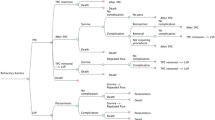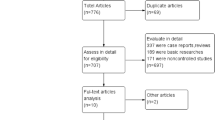Abstract
Purpose
Management of refractory ascites traditionally includes medical treatment with diuretics or intermittent paracentesis. Patients with recurrent ascites may benefit from the use of permanent intra-abdominal catheters with more frequent drainage without hospitalization. The objective was to systematically asses the methodology of factors and endpoints reported in studies investigating permanent catheters for recurrent ascites treatment.
Methods
Using a systematic search strategy, we critically assessed the methodology when treating refractory ascites using a permanent catheter. Studies critically assessed included both retro- and prospective studies.
Results
A total of 715 unique articles were found via PubMed, The Cochrane Library and Embase. Twenty-nine studies (tunnelled catheter = 12, peritoneal ports = 6 and peritoneovenous shunts = 11) with three distinct types of permanent catheters fulfilled the inclusion criteria. Only three studies reported technical success less than 100 %. Data on complications and treatment were not available in all papers; peritonitis (48 %), cellulitis (41 %), prophylactic antibiotics (48 %) and complications to catheter insertion were difficult to distinguish from advanced co-morbidity of patients. Thirteen studies (45 %) reported some type of evaluating patient experience or functional outcome, but only three studies used validated reproducible scales when assessing outcomes. Fifteen of the 29 studies included 30 patients or less.
Conclusion
Knowledge is limited because complications and outcomes are poorly defined. The expected increase in catheter treatment of refractory ascites necessitates comparative studies, using validated patient-related outcomes, and the reporting of unambiguous complications. A proposal of variables to include in future studies is presented.

Similar content being viewed by others
References
Coupe NA, Cox K, Clark K, Boyer M, Stockler M (2013) Outcomes of permanent peritoneal ports for the management of recurrent malignant ascites. J Palliat Med 2013(16):938–940
Lungren MP, Kim CY, Stewart JK, Smith TP, Miller MJ (2013) Tunneled peritoneal drainage catheter placement for refractory ascites: single-center experience in 188 patients. J Vasc Interv Radiol 2013(24):1303–1308
Ginès A, Planas R, Angeli P, et al. (1995) Treatment of patients with cirrhosis and refractory ascites using LeVeen shunt with titanium tip: comparison with therapeutic paracentesis. Hepatology 1995(22):124–131
Ginès P, Arroyo V, Vargas V, et al. (1991) Paracentesis with intravenous infusion of albumin as compared with peritoneovenous shunting in cirrhosis with refractory ascites. N Engl J Med 1991(325):829–835
Rosenberg S, Courtney A, Nemcek AA Jr, Omary RA (2004) Comparison of percutaneous management techniques for recurrent malignant ascites. J Vasc Interv Radiol 2004(15):1129–1131
Seike M, Maetani I, Sakai Y (2007) Treatment of malignant ascites in patients with advanced cancer: peritoneovenous shunt versus paracentesis. J Gastroenterol Hepatol 2007(22):2161–2166
Courtney A, Nemcek AA Jr, Rosenberg S, Tutton S, Darcy M, Gordon G (2008) Prospective evaluation of the PleurX catheter when used to treat recurrent ascites associated with malignancy. J Vasc Interv Radiol 2008(19):1723–1731
Liberati A, Altman DG, Tetzlaff J, et al. (2009) The PRISMA statement for reporting systematic reviews and meta-analyses of studies that evaluate health care interventions: explanation and elaboration. PLoS Med 6:e1000100
National Center for Biotechnology Information. PubMed Help. http://www.ncbi.nlm.nih.gov/books/NBK3827/. Accessed on 1–4-2015
Savin MA, Kirsch MJ, Romano WJ, Wang SK, Arpasi PJ, Mazon CD (2005) Peritoneal ports for treatment of intractable ascites. J Vasc Interv Radiol 2005(16):363–368
Tapping CR, Ling L, Razack A (2012) PleurX drain use in the management of malignant ascites: safety, complications, long-term patency and factors predictive of success. Br J Radiol 2012(85):623–628
Barnett TD, Rubins J (2002) Placement of a permanent tunneled peritoneal drainage catheter for palliation of malignant ascites: a simplified percutaneous approach. J Vasc Interv Radiol 2002(13):379–383
Akinci D, Erol B, Ciftci TT, Akhan O (2011) Radiologically placed tunneled peritoneal catheter in palliation of malignant ascites. Eur J Radiol 2011(80):265–268
Narayanan G, Pezeshkmehr A, Venkat S, Guerrero G, Barbery K (2014) Safety and efficacy of the Pleurx catheter for the treatment of malignant ascites. Journal of Palliative Medicine 2014(17):906–912
Abdel Ghaffar MK, Hassan MS, Mostafa MY (2014) Value of implantable peritoneal ports in managing recurrent malignant ascites. Egyptian Journal of Radiology and Nuclear Medicine 2014(45):417–422
Lee A, Lau TN, Yeong KY (2000) Indwelling catheters for the management of malignant ascites. Support Care Cancer 2000(8):493–499
Mercadante S, Intravaia G, Ferrera P, Villari P, David F (2008) Peritoneal catheter for continuous drainage of ascites in advanced cancer patients. Support Care Cancer 2008(16):975–978
O’Neill MJ, Weissleder R, Gervais DA, Hahn PF, Mueller PR (2001) Tunneled peritoneal catheter placement under sonographic and fluoroscopic guidance in the palliative treatment of malignant ascites. AJR Am J Roentgenol 2001(177):615–618
Ozkan O, Akinci D, Gocmen R, Cil B, Ozmen M, Akhan O (2007) Percutaneous placement of peritoneal port-catheter in patients with malignant ascites. Cardiovasc Intervent Radiol 2007(30):232–236
Park JS, Won JY, Park SI, Park SJ, Lee DY (2001) Percutaneous peritoneovenous shunt creation for the treatment of benign and malignant refractory ascites. J Vasc Interv Radiol 2001(12):1445–1448
Richard HM III, Coldwell DM, Boyd-Kranis RL, Murthy R, Van Echo DA (2001) Pleurx tunneled catheter in the management of malignant ascites. J Vasc Interv Radiol 2001(12):373–375
Rosenblum DI, Geisinger MA, Newman JS, et al. (2001) Use of subcutaneous venous access ports to treat refractory ascites. J Vasc Interv Radiol 2001(12):1343–1346
Zanon C, Grosso M, Apra F, et al. (2002) Palliative treatment of malignant refractory ascites by positioning of Denver peritoneovenous shunt. Tumori 2002(88):123–127
Millard FC, Powis SJA (1988) Management of intractable malignant ascites using the Denver peritoneovenous shunt. J R Coll Surg Edinb 1988(33):138–139
Monsky WL, Yoneda KY, MacMillan J, et al. (2009) Peritoneal and pleural ports for management of refractory ascites and pleural effusions: assessment of impact on patient quality of life and hospice/home nursing care. J Palliat Med 2009(12):811–817
Bratby MJ, Hussain FF, Lopez AJ (2007) Radiological insertion and management of peritoneovenous shunt. Cardiovasc Intervent Radiol 2007(30):415–418
Shepherd KE, Miller BJ (1988) Peritoneovenous shunts—devices of last resort. Can J Surg 1988(31):444–447
Sugawara S, Sone M, Arai Y, et al. (2011) Radiological insertion of Denver peritoneovenous shunts for malignant refractory ascites: a retrospective multicenter study (JIVROSG-0809). Cardiovasc Intervent Radiol 2011(34):980–988
Tomiyama K, Takahashi M, Fujii T, et al. (2006) Improved quality of life for malignant ascites patients by Denver peritoneovenous shunts. Anticancer Res 2006(26):2393–2395
Guzman E, Wigness BD, Dorman FD, Rohde TD, Buchwald H (1988) Advances and new concepts in the designing of peritoneovenous shunts for the treatment of refractory ascites. ASAIO Trans 1988(34):805–807
Po CL, Bloom E, Mischler L, Raja RM (1996) Home ascites drainage using a permanent Tenckhoff catheter. Adv Perit Dial 1996(12):235–236
Easson AM, Bezjak A, Ross S, Wright JG (2007) The ability of existing questionnaires to measure symptom change after paracentesis for symptomatic ascites. Ann Surg Oncol 2007(14):2348–2357
Abdel-Aal AK, Dybbro P, Hathaway P, Guest S, Neuwirth M, Krishnamurthy V (2014) Best practices consensus protocol for peritoneal dialysis catheter placement by interventional radiologists. Perit Dial Int 2014(34):481–493
Hagen SM, Lafranca JA, IJzermans JN, Dor FJ (2014) A systematic review and meta-analysis of the influence of peritoneal dialysis catheter type on complication rate and catheter survival. Kidney Int 2014(85):920–932
Barretti P, Doles JV, Pinotti DG, El Dib RP (2015) Evidence-based medicine: an update on treatments for peritoneal dialysis-related peritonitis. World J Nephrol 2015(4):287–294
Author information
Authors and Affiliations
Corresponding author
Ethics declarations
Conflicts of interest
All authors declare no conflicts of interest. Data analysed is controlled by the authors of the papers included in this review. Our data is available for review by Supportive Care in Cancer upon request.
Funding
The funding was purely departmental/institutional.
Electronic Supplementary Materials
ESM 1
(DOCX 16 kb)
Rights and permissions
About this article
Cite this article
Christensen, L., Wildgaard, L. & Wildgaard, K. Permanent catheters for recurrent ascites—a critical and systematic review of study methodology. Support Care Cancer 24, 2767–2779 (2016). https://doi.org/10.1007/s00520-016-3145-y
Received:
Accepted:
Published:
Issue Date:
DOI: https://doi.org/10.1007/s00520-016-3145-y




